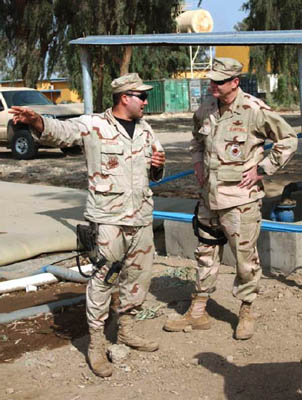About 20 airmen are working with the Iraqi Army at remote Camp Habbaniyah. Where “everything is a challenge [and] nothing comes easy,” says TSgt. James Lovelace, senior enlisted advisor for the camp’s USAF unit. The Red Tail Flyer reports that the airmen’s job is to teach Iraqi soldiers how to operate a military organization, ranging from such basics as providing food, water, electricity, fuel, and waste management. Lt. Col. Sharyn McWhorter, officer in charge of USAF’s regional support unit Habbinayah, says there wasn’t even a “scheme for picking up trash.” Some 50 years ago, the camp was a functional base; now living quarters may not have running water or electricity and supplies are scarce. The airmen subsist on local food and care packages from home.
20 airmen are working with the Iraqi Army at remote Camp Habbaniyah. Where “everything is a challenge [and] nothing comes easy,” says TSgt. James Lovelace, senior enlisted advisor for the camp’s USAF unit. The Red Tail Flyer reports that the airmen’s job is to teach Iraqi soldiers how to operate a military organization, ranging from such basics as providing food, water, electricity, fuel, and waste management. Lt. Col. Sharyn McWhorter, officer in charge of USAF’s regional support unit Habbinayah, says there wasn’t even a “scheme for picking up trash.” Some 50 years ago, the camp was a functional base; now living quarters may not have running water or electricity and supplies are scarce. The airmen subsist on local food and care packages from home.
The Space Development Agency says it’s on track to issue its next batch of missile warning and tracking satellite contracts this month after those awards were delayed by the Pentagon’s decision to divert funds from the agency to pay troops during this fall’s prolonged government shutdown.

